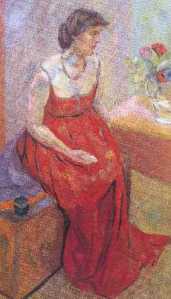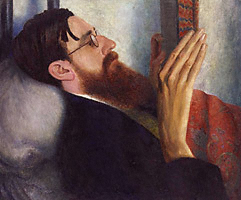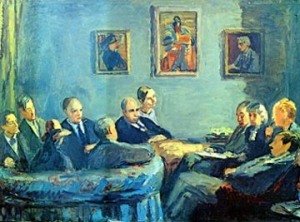Portrait of Vanessa Bell by Roger Fry 1916: Wikipedia, Public Domain.
Vanessa was Virginia’s sister and like Virginia, she was educated at home. She studied languages, maths and history and had drawing lessons. Vanessa went on to study painting at the Royal Academy, London and at the Slade School of Art.
During my research for this post, I have read that Vanessa began at ‘The Slade’ in 1901. The Slade is the art school of The University College London and is world renowned. However, though she apparently started there I can’t see her name amongst the Slade’s notable alumni, nor indeed on any alumni list. I can see Duncan Grant’s name there (and incidentally, Antony Gormley’s*) but not Vanessa’s.
I wonder if Vanessa actually finished her degree?
Vanessa Stephen married Clive Bell in 1907 and although they remained close and never divorced, she drifted in to a relationship with Duncan Grant. They had the same artistic taste and were on the same wavelength in their creativity. Duncan had homosexual relationships but remained close to Vanessa and they had a daughter, Angelica, together.
Vanessa excelled in portraits but she preferred to paint still lifes and interiors until in 1914 she focused more on abstraction. Vanessa was influenced by viewing works by Picasso and Manet which turned her attentions towards abstract painting. Her paintings showed a departure from reality, compositions were simplified and colours were vibrant. Vanessa chose real life subject matter but she distorted colour and form by simplifying the subject and using broad bands of colour. In one painting of Virginia she paints none of her facial features; a characteristic of abstract painting.
Abstract painting exists on a scale of departure from reality. Forgive my ignorance as I am not an expert in the visual arts but I see abstraction as being on a scale from 1-10 with 1 being a recognisable realistic interpretation of a subject (e.g. a portrait that you can recognise as a person) to 10 being unrecognisable as any real life subject.
In my degree days we briefly studied Rothko and his paintings using blocks of colour and rectangular shapes. These are paintings that I would score as a ’10’ on my abstraction scale and indeed, Vanessa did paint in this manner. However, the painting I mentioned above that shows no facial features I would score as perhaps a ‘4’ as Virginia is clearly recognisable as a person even if not as herself.
Vanessa’s creativity did not stop at paintings. Her style was to decorate walls, doors, furniture, ceramics, fabric, and in fact any surface you could think of. When I visited Charleston Farmhouse earlier this year, I noticed that even the side of the bath didn’t escape!
- Gormley is another of my faves but maybe that needs to be another blog!







